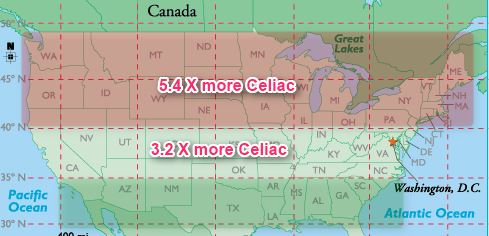Celiac disease 5.4 times more likely in Northern vs Southern states (vitamin D)
Lower Prevalence of Celiac Disease and Gluten-Related Disorders in Persons Living in Southern vs Northern Latitudes of the United States.
Gastroenterology. 2017 Feb 23. pii: S0016-5085(17)30176-2. doi: 10.1053/j.gastro.2017.02.012. [Epub ahead of print]
Unalp-Arida A1, Ruhl CE2, Choung RS3, Brantner TL3, Murray JA3.
1 National Institute of Diabetes and Digestive and Kidney Diseases, National Institutes of Health, Department of Health and Human Services, Two Democracy Plaza, Room 6009 6707 Democracy Blvd. Bethesda, MD. Electronic address: aynur.unalp-arida@nih.gov.
2 Social & Scientific Systems, Inc., 8757 Georgia Avenue, 12(th) floor, Silver Spring, MD. Electronic address: cruhl@s-3.com.
3 Division of Gastroenterology and Hepatology, Mayo Clinic, Rochester, MN.

📄 Download the PDF from VitaminDWiki
BACKGROUND & AIMS:
The association between prevalence of celiac disease and geographic region is incompletely understood, but the occurrence of several autoimmune disorders has been found to vary along a North-South gradient. We examined geographic, demographic, and clinical factors associated with prevalence of celiac disease and gluten-free diet (GFD) in the United States (US).
METHODS:
In a population-based study, we analyzed data on gluten-related conditions from the US National Health and Nutrition Examination Survey, from 2009 through 2014, on 22,277 participants 6 years and older. We identified persons with celiac disease, based on results of serum tests for immunoglobulin A against tissue transglutaminase and endomysium or on both a health care provider diagnosis and adherence to a GFD. Gluten-avoidance without celiac disease was defined as adherence to a GFD without a diagnosis of celiac disease. We compared mean serum levels of biochemical and nutritional markers based on status of gluten-related conditions.
RESULTS:
We found 0.7% of participants to have celiac disease and 1.1% of participants to avoid gluten without celiac disease.
Celiac disease was more common among individuals who lived at
latitudes of 35-39º North (odds ratio, 3.2 ; 95% CI, 1.4-7.1) or at
latitudes of 40º North or more (odds ratio, 5.4 ; 95% CI, 2.6-11.3)
than individuals who lived at latitudes below 35º North independent of race or ethnicity, socioeconomic status, and body mass index.
Gluten-avoidance without celiac disease was more common among individuals who lived at latitudes of 40º North or more, independent of demographic factors and body mass index.
Participants with undiagnosed celiac disease (identified by positive results from serologic tests) had lower mean levels of B12 and folate (data collected from 2009 through 2012) than persons without celiac disease.
Participants with a health-care provider diagnosis of celiac disease had a lower mean level of hemoglobin than persons without celiac disease. Mean levels of albumin, calcium, iron, ferritin, cholesterol, vitamin B6, and vitamin D (data collected from 2009 through 2010) did not differ between participants with gluten-related conditions and those without.
CONCLUSIONS:
In the US population, a higher proportion of persons living at latitudes of 35º North or greater have celiac disease and/or avoid gluten than persons living south of this latitude, independent of race or ethnicity, socioeconomic status, or body mass index. Mean levels of B12 and folate are lower in individuals with undiagnosed celiac disease, and levels of hemoglobin are lower in participants with a diagnosis of celiac disease, compared to individuals without celiac disease.
